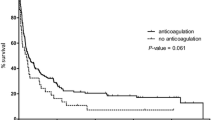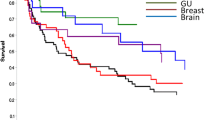Abstract
Venous thromboembolism (VTE) is a common complication in cancer patients and anticoagulation (AC) remains the standard of care for treatment. Inferior vena cava (IVC) filters may also used to reduce the risk of pulmonary embolism, either alone or in addition to AC. Although widely used, data are limited on the safety and efficacy of IVC filters in cancer patients. We performed a retrospective review of outcomes after IVC filter insertion in a database of 1270 consecutive patients with cancer-associated pulmonary embolism (PE) at our institution between 2008 and 2009. Outcomes measured included rate of all recurrent VTE, recurrent PE, and overall survival within 12 months. 317 (25%) of the 1270 patients with PE had IVC filters placed within 30 days of the index PE event or prior to the index PE in the setting of prior DVT. Patients with IVC filters had markedly lower overall survival (7.3 months) than the non-IVC filter patients (13.2 months). Filter patients also had a lower rate of AC use at time of initial PE. There was a trend towards higher recurrent VTE in patients with IVC filters (11.9%) compared to non-filter patients (7.7%), but this was not significant (p = 0.086). The risk of recurrent PE was similar between the IVC filter cohort (3.5%) and non-filter group (3.5%, p = 0.99). Cancer patients receiving IVC filters had a similar risk of recurrent PE, but a trend towards more overall recurrent VTE. The filter patients had poorer overall survival, which may reflect a poorer cancer prognosis, and had greater contraindication to AC; therefore these patients likely had a higher inherent risk for recurrent VTE. A prospective study would be helpful for further clarification on the partial reduction in the recurrent PE risk by IVC filter placement in cancer patients.
Similar content being viewed by others
References
Blom JW, Doggen CJ, Osanto S, Rosendaal FR (2005) Malignancies, prothrombotic mutations, and the risk of venous thrombosis. JAMA 293(6):715–722
Heit JA, O’Fallon WM, Petterson TM, Lohse CM, Silverstein MD, Mohr DN et al (2002) Relative impact of risk factors for deep vein thrombosis and pulmonary embolism: a population-based study. Arch Intern Med 162(11):1245–1248
Stein PD, Matta F, Hull RD (2011) Increasing use of vena cava filters for prevention of pulmonary embolism. Am J Med 124(7):655–661
Duszak R Jr, Parker L, Levin DC, Rao VM (2011) Placement and removal of inferior vena cava filters: national trends in the medicare population. J Am Coll Radiol 8(7):483–489
Muriel A, Jimenez D, Aujesky D, Bertoletti L, Decousus H, Laporte S et al (2014) Survival effects of inferior vena cava filter in patients with acute symptomatic venous thromboembolism and a significant bleeding risk. J Am Coll Cardiol 63(16):1675–1683
PREPIC Study Group (2005) Eight-year follow-up of patients with permanent vena cava filters in the prevention of pulmonary embolism: the PREPIC (Prevention du Risque d’Embolie Pulmonaire par Interruption Cave) randomized study. Circulation 112(3):416–422
Decousus H, Leizorovicz A, Parent F, Page Y, Tardy B, Girard P et al (1998) A clinical trial of vena caval filters in the prevention of pulmonary embolism in patients with proximal deep-vein thrombosis. Prevention du Risque d’Embolie Pulmonaire par Interruption Cave Study Group. N Engl J Med 338(7):409–415
Mismetti P, Laporte S, Pellerin O, Ennezat PV, Couturaud F, Elias A et al (2015) Effect of a retrievable inferior vena cava filter plus anticoagulation vs anticoagulation alone on risk of recurrent pulmonary embolism: a randomized clinical trial. JAMA 313(16):1627–1635
Wallace MJ, Jean JL, Gupta S, Eapen GA, Johnson MM, Ahrar K et al (2004) Use of inferior vena caval filters and survival in patients with malignancy. Cancer 101(8):1902–1907
Mikhail S, Hannan L, Pishvaian MJ, Kessler C (2015) Retrievable inferior vena cava filters in patients with cancer are safe but are they beneficial? Med Oncol 32(6):622
Norden AD, Bartolomeo J, Tanaka S, Drappatz J, Ciampa AS, Doherty LM et al (2012) Safety of concurrent bevacizumab therapy and anticoagulation in glioma patients. J Neurooncol 106(1):121–125
Yust-Katz S, Mandel JJ, Wu J, Yuan Y, Webre C, Pawar TA et al (2015) Venous thromboembolism (VTE) and glioblastoma. J Neurooncol 124(1):87–94
Weinstock MJ, Uhlmann EJ, Zwicker JI (2016) Intracranial hemorrhage in cancer patients treated with anticoagulation. Thromb Res 140(Suppl 1):S60–S65
Kaufman JA, Kinney TB, Streiff MB, Sing RF, Proctor MC, Becker D et al (2006) Guidelines for the use of retrievable and convertible vena cava filters: report from the Society of Interventional Radiology multidisciplinary consensus conference. J Vasc Interv Radiol 17(3):449–459
Barginear MF, Lesser M, Akerman ML, Strakhan M, Shapira I, Bradley T et al (2009) Need for inferior vena cava filters in cancer patients: a surrogate marker for poor outcome. Clin Appl Thromb/Hemost 15(3):263–269
Ho G, Brunson A, White R, Wun T (2015) Vena cava filter use in cancer patients with acute venous thromboembolism in California. Thromb Res 135(5):809–815
Barginear MF, Gralla RJ, Bradley TP, Ali SS, Shapira I, Greben C et al (2012) Investigating the benefit of adding a vena cava filter to anticoagulation with fondaparinux sodium in patients with cancer and venous thromboembolism in a prospective randomized clinical trial. Support Care Cancer 20(11):2865–2872
Funding
This research was funded in part through the NIH/NCI, Cancer Center Support Grant P30 CA008748.
Author information
Authors and Affiliations
Corresponding author
Ethics declarations
Conflict of interest
All authors declare that they have no conflict of interest.
Ethical approval
All procedures performed in studies involving human participants were in accordance with the ethical standards of the institutional and/or national research committee and with the 1964 Helsinki declaration and its later amendments or comparable ethical standards.
Rights and permissions
About this article
Cite this article
Coombs, C., Kuk, D., Devlin, S. et al. Outcomes after inferior vena cava filter placement in cancer patients diagnosed with pulmonary embolism: risk for recurrent venous thromboembolism. J Thromb Thrombolysis 44, 489–493 (2017). https://doi.org/10.1007/s11239-017-1557-2
Published:
Issue Date:
DOI: https://doi.org/10.1007/s11239-017-1557-2




